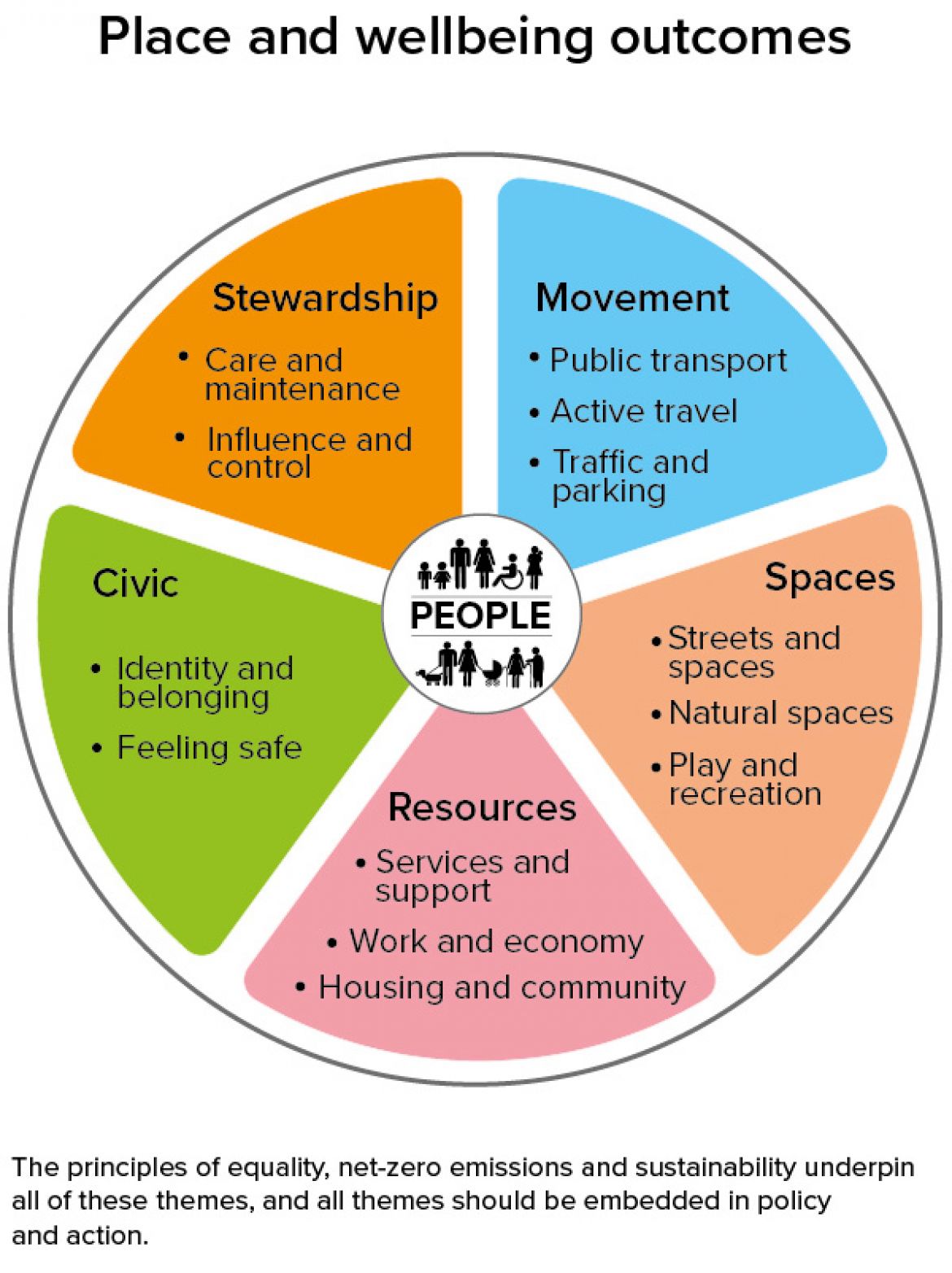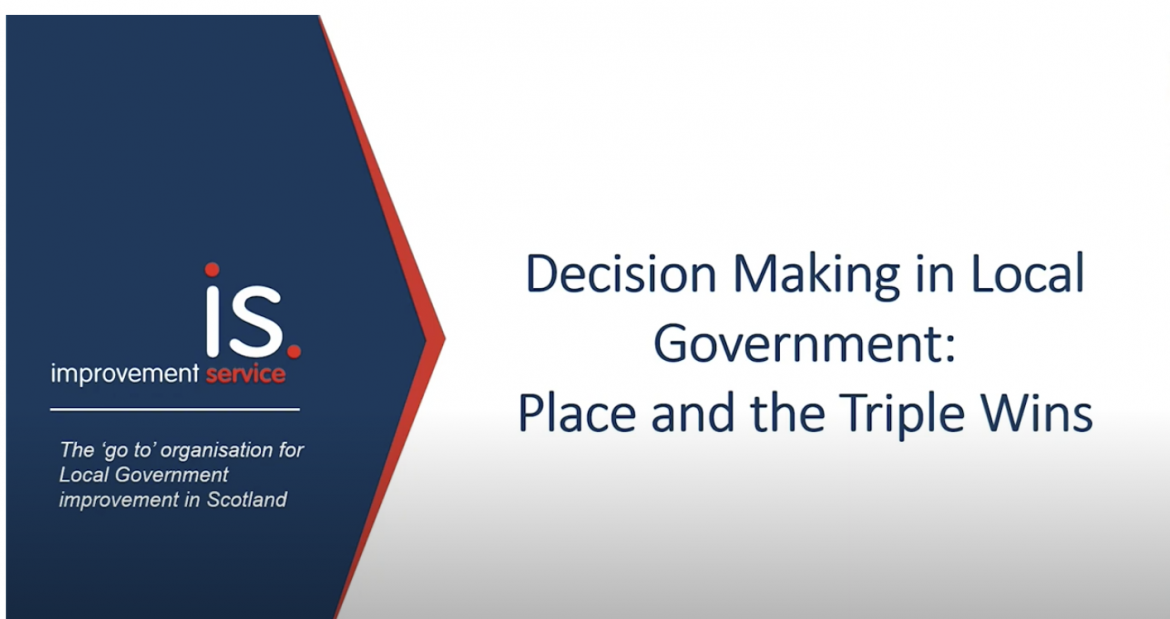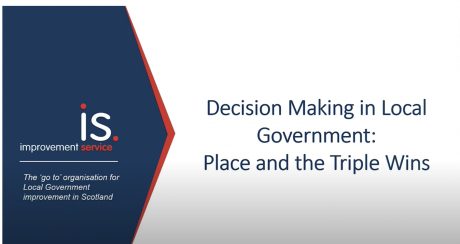What is a place-based approach?
A Place-based approach requires joint working, collaborative work that takes account of the unique blend of characteristics that exist in every place. By doing so it will identify and maximise the positive impact and reduce any unintended consequences of our actions. This approach enables better informed decisions leading to the delivery of more effective services and more resilient communities.
As no two places are the same, neither will any two place-based approaches be the same. However, through applying all three parts of a place-based approach we can identify and target the underlying causes of inequalities and disadvantage and implement solutions that are tailored to the individual challenges which face different places across Scotland. It's not about reinventing the wheel but building on peoples existing capabilities and strengthening our relationships.
With the shared input of all those responsible for providing services and looking after assets, we can identify the steps that need to be taken to overcome inequality and disadvantage. That joint input is the key to the success of place-based working and every effort must be made to ensure collaborative buy in to help realise our communities’ full potential.
A place-based approach may have different rationales and flexibility in its objective but what is consistent is that:
- it addresses complex problems that no one service working alone can solve.
- prevention is now regarded as a key feature of new approaches.
- approaches involve breaking down organisational silos and bringing sectors together around a shared ambition when designing and delivering services.
For local government this means councils working with partners to integrate services around the needs of people in a place, with an emphasis on prevention and early intervention. All aimed at reducing inequalities.
Coordinated place-based approaches can be applied at a range and scale of settings and circumstances be that in remote villages, towns, cities, regions, or islands. Solutions need to deliver across the range of economic, physical, and social outcomes and involve utilising available resources from across mainstream budgets.
How can we deliver a place-based approach?
All place-based approaches require a way of working that takes account of the varied social, economic, and physical characteristics in every place to enable each of these features to co-exist in every place. The Place and Wellbeing Outcomes, developed by the Place and Wellbeing Collaborative, evidence the range of factors impacting the wellbeing of people and planet.

The Outcomes fall into five overarching themes of:
- Movement
- Stewardship.
- Spaces
- Resources
- Civic
These Outcomes are interlinked: interventions with one Outcome having a knock-on impact on achieving the other Outcomes. Thus, a place-based approach is the basis for their delivery.
The Shaping Places for Wellbeing programme stemmed from the desire to use these Outcomes to ensure the impact of decisions consider every aspect of place and to fully understand the contribution of our places as part of the preventative solution when addressing the range of priorities facing local councils and local health boards across Scotland.
Examples where a place-based approach can help
Decision making in local government: Place and Triple Wins
In this short video, Irene Beautyman and Miriam McKenna explain how the decisions made about the places we live, work, and play can bring benefits for health and wellbeing, for the climate, and for reducing inequalities.
Community planning
Closer working between service providers to improve outcomes for communities is the foundation of successful community planning. It is also the foundation for place-based approaches to achieving outcomes. Requirements introduced through the Community Empowerment Act have implications for the spatial planning role undertaken by local authorities. The Act introduced Local Outcome Improvement Plans (LOIPs) which allow the key priorities and needs of communities, that have been identified through various engagement processes, to be officially accounted for. These Plans provide an approach to working with, and giving power to, local communities by allowing them to influence and shape their local area.
Spatial Planning
National Planning Framework 4
The purpose of spatial planning is to manage the use of land and buildings in the public long-term interest. The Planning (Scotland) Act 2019 sets out the statutory requirements and processes of the Scottish planning system. The introduction of the Act means that the National Planning Framework forms part of the statutory development plan for planning purposes. The National Planning Framework establishes a long-term vision for development and investment across Scotland over the next 20 to 30 years. It plays a key role in supporting the delivery of Scotland’s national outcomes as well as the United Nations (UN) Sustainable Development Goals (SDG).
Crucially the Act introduced a set of 6 new outcomes for National Planning Framework 4 to deliver. Their inclusion means spatial planning is now required to consider climate change, peoples wellbeing and reducing inequality when determining "the public long-term interest.
Equally crucial is that spatial planning cannot deliver on the asks of the new National Planning Framework on its own. A collaborative, place-based approach will greatly aid delivery.
Local Development Plans (LDPs)
All planning authorities are legally required to prepare one or more Local Development Plans for their area. These Plans allocate sites for either new development or sites to be protected and provide the policies that guide decisions made on planning applications. Local Development Plans must also consider the National Planning Framework, the Authority’s adopted Regional Spatial Strategy, as well as any registered Local Place Plans and Local Outcome Improvement Plans. This ensures better alignment with the wider activities and objectives arising from community planning under the Community Empowerment Act and also guarantees practical benefits such as joined-up and effective community engagement, and consistent prioritisation of council and partner policy objectives.
Local Place Plans
A requirement introduced by the Planning (Scotland) Act 2019 is Local Place Plans. Local Place Plans are a new type of plan that provide communities with the opportunity to create proposals for development and use of land in their local area. The Act stipulated that these plans are to be community led and should be prepared through community engagement that is both inclusive and robust. The Scottish Government has published a draft version of a How-to-guide for Local Place Plans which can be found on the Scottish Government website.
Local living and 20 Minute Neighbourhoods
The principle of local living/ 20-minute neighbourhood requires a place-based approach to enable more local living and thereby support everybody’s choices to enhance wellbeing for our people and planet. The Planning for Place Programme supports local government and councils to progress Scottish Government's ambition for local living and 20-minute neighbourhoods. This includes an Elected Member Briefing Note describing the key features of this ambition and its application across all of Scotland, from remote rural communities to cities and towns.
Taking a trauma-informed lens to a place-based approach
A trauma-informed approach and a place-based approach should both be seen as part of a broader ambition to improve the outcomes of individuals and communities across Scotland, and to tackle inequalities, adversity and trauma in all their forms. Taking a trauma-informed lens to a place-based approach can ensure that the environment around those of us who have experienced trauma responds to our needs and provides us with the support we need for recovery. Explore more about how the two approaches can inform and support each other in this briefing: Taking a Trauma-Informed Lens to a Place-Based Approach.
If you are looking to take a place-based approach, or if you want to know more about the Place and Wellbeing Outcomes, please get in touch at PlaceandWellbeing@improvementservice.org.uk, or follow us on X @PlaceNetworkSco to keep up to date with all of our latest news.
-
Place Network
For those interested in the importance of place as a working approach to delivering national outcomes around improved wellbeing and inclusive growth.
-
Shaping Places for Wellbeing Place-based Approach
The Shaping Places for Wellbeing Programme is a joint delivery partnership between the Improvement Service and Public Health Scotland. This forum is for those interested in our work supporting the role of place to reduce inequality and improve the wellbeing of people and planet.

